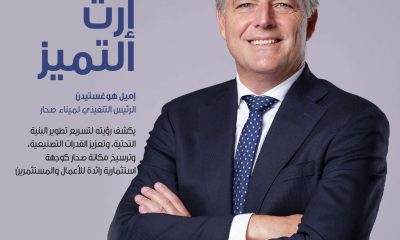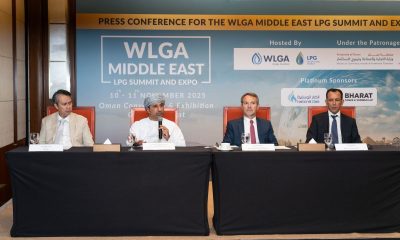Banking & Finance
Bank assets grow by 16 per cent to OMR28b
Total assets of commercial banks increased by 15.7 per cent to OMR28.3 billion in October 2015 from OMR24.5 billion a year ago. Of the total assets, credit disbursement accounted for 65 per cent and increased by 10.4 per cent as at the end of October 2015 to OMR18.4 billion.

Total assets of commercial banks increased by 15.7 per cent to OMR28.3 billion in October 2015 from OMR24.5 billion a year ago. Of the total assets, credit disbursement accounted for 65 per cent and increased by 10.4 per cent as at the end of October 2015 to OMR18.4 billion.
Credit to the private sector increased by 10.8 per cent to reach OMR16.0 billion as at the end of October 2015. Of the total credit to the private sector as at the end of October 2015, the share of the non-financial corporate sector stood at 46.8 per cent, closely followed by the household sector (mainly under personal loans) at 45.2 per cent, financial corporations at 5.4 per cent and other sectors the remaining 2.6 per cent.
Commercial banks’ overall investments in securities declined by 12.5 per cent to OMR2.6 billion as at the end of October 2015 from OMR3 billion a year ago.
The drop resulted mainly in bank’s investments in Central Bank of Oman’s (CBO) certificates of deposits, which fell from OMR1.4 billion in October 2014 to zero in October 2015. Investment in government development bonds, however, increased by 32.5 per cent over the year to OMR751.7 million at the end of October 2015.
Banks also invested OMR294.5 million in Government Treasury Bills as at the end of October 2015. Commercial banks’ investments in foreign securities stood at OMR717.1 million in October 2015. Aggregate deposits held with commercial banks registered an increase of 5.9 per cent to OMR18.2 billion in October 2015 from OMR17.1 billion a year ago.
Government deposits with commercial banks increased by 0.3 per cent to OMR5.1 billion. Deposits of public enterprises increased by 13.4 per cent to OMR1 billion during the same period. Private sector deposits, which constituted 64.9 per cent of total deposits with commercial banks, increased by 8.1 per cent to OMR11.8 billion in October 2015 from OMR10.9 billion a year ago.
Sector-wise, the share of households was 49.6 per cent of the total private sector deposit base, followed by non-financial corporations at 28.6 per cent, financial corporations at 19.1 per cent and other sectors at 2.7 per cent.
Islamic banking entities provided financing to the extent of OMR1.6 billion as at the end of October 2015 when compared to OMR0.95 billion a year ago. Total deposits held with Islamic banks and windows also registered a significant increase to OMR1.4 billion in October 2015 from OMR0.5 billion outstanding as at the end of October 2014. The total assets of Islamic banks and windows amounted to OMR2 billion as at the end of October 2015, which constituted about 6.6 per cent of the banking system assets.
As at the end of October 2015, narrow money stock (M1) when measured on year-on-year basis, grew by 12.8 per cent to OMR5.3 billion. This rise was a result of increase in currency with the public by 7.7 per cent coupled with increase in demand deposits by 14.5 per cent.
Broad money supply stood at OMR14.9 billion at the end of October 2015, up from OMR13.3 billion a year ago, registering an increase of 11.6 per cent during the period.
In respect of domestic interest rate structure of commercial banks, both deposit and lending rates softened during this period. The weighted average interest rate on rial Omani deposits declined from 1.009 per cent in October 2014 to 0.898 per cent in October 2015 while the weighted average rial Omani lending rate decreased from 5.138 per cent to 4.749 per cent during the same period.
The overnight rial Omani domestic inter-bank lending rate firmed up to 0.155 per cent in October 2015 from 0.133 per cent a year ago.
Annual inflation rate, calculated in terms of consumer price index, for the Sultanate stood at 0.14 per cent during January-October 2015 over the corresponding period in 2014. A robust growth of monetary aggregates in the Sultanate continued despite the decline in crude oil prices, which commenced in the second half of 2014.
The Central Bank of Oman (CBO) ensured that sufficient liquidity prevailed in the banking system, credit demand was fully met and orderly conditions were maintained in the markets. With the decline in oil prices, the petroleum sector’s nominal GDP contracted by 38.2 percent in the first half of 2015 over similar period in the previous year. However, the non-oil sector performed well and preliminary data reveals a 3.7 percent growth in nominal terms during the first half of 2015. It is expected that with continued investment in important projects, domestic demand will be sustained and the non-oil economic activities will be strengthened.
-

 Magazines2 months ago
Magazines2 months agoOER – September 2025 Issue
-

 Alamaliktistaad Magazines1 month ago
Alamaliktistaad Magazines1 month agoAlam Al Iktisaad – September 2025 Edition
-

 News1 month ago
News1 month agoKitchenomiKs Secures Investment of US$3.2M Led by Jasoor Ventures
-

 News2 months ago
News2 months agoCent Capital, AI Finance App by ex-AWS Strategist ‘The Beast of Bay Area,’ Launches to End Financial Anxiety, Hits $1M AUM
-

 News1 month ago
News1 month agoOman Inaugurates ‘Hadatha’ – Its All-New Cybersecurity Center
-

 Banking & Finance1 month ago
Banking & Finance1 month agoOman Arab Bank Highlights Its Ongoing Strategic Initiatives and Future Plans
-

 News1 month ago
News1 month agoIEA Expects Global Oil Market to Remain Oversupplied in 2026
-

 Energy1 month ago
Energy1 month agoWLGA Middle East LPG Summit & Expo 2025 to be held at OCEC on November 10 and 11































You must be logged in to post a comment Login